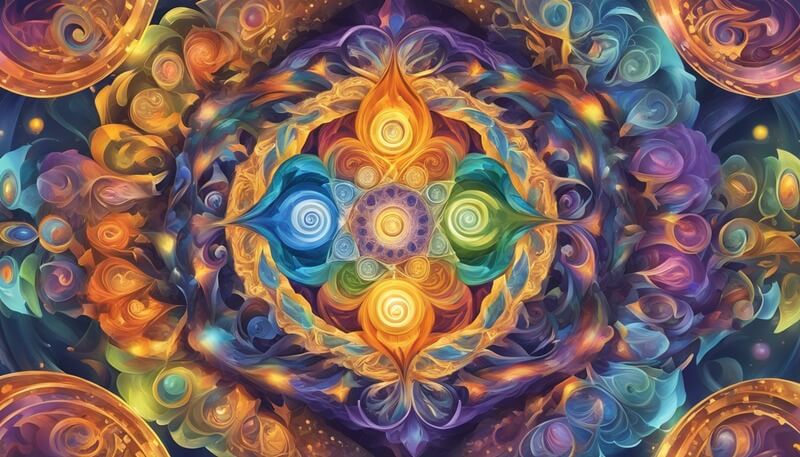Jungian dream analysis represents a profound and distinctive approach to understanding the human psyche through our dreams. Developed by Swiss psychiatrist Carl Jung, this method delves into the interpretation of dreams to uncover the language of the unconscious.
Jung believed that dreams are a bridge to the unconscious mind and offer a means to integrate our conscious and unconscious experiences, a concept central to his theory of individuation. He posited that the symbols and themes appearing in dreams are personal and collective unconscious material that, when interpreted, can lead to valuable insights into one’s inner life.
The Jungian dream analysis process involves examining dreams’ symbolic content to interpret their meaning. Dreams are not seen merely as random neural activities during sleep but rather as carriers of significant messages from the deeper aspects of the psyche.
One of the core elements of Jung’s theory is the use of archetypal images and symbols—universal themes that resonate with psychic experiences shared by humanity. By exploring these symbols within an individual’s life context, it is possible to shed light on psychological patterns and dynamics that influence behavior and emotional well-being.
Visit: Dream Mood Dictionary
Fundamentals of Jungian Dream Analysis

Jungian dream analysis is a profound method developed by Carl Jung, focusing on the interpretation of dreams to unravel the workings of the unconscious mind. It employs a unique approach to psychoanalysis, distinguishing itself through an emphasis on symbols and archetypes as tools for self-realization.
Key Principles
Several key principles underpin Jungian dream analysis. Firstly, dreams are viewed as direct communications from the unconscious, providing invaluable insights into an individual’s inner world. Dreams serve multiple functions—from forecasting potential future events to facilitating psychological balance. They are not random but meaningful manifestations of the unconscious, with each element purposefully contributing to the dream’s message.
Secondly, Jung’s conceptualization of the psyche is divided into three parts: the ego, personal, and collective unconscious. The personal unconscious contains temporarily forgotten information and repressed experiences, while the collective unconscious houses archetypes—universal, inherited potentials that shape human behavior and experiences.
Role of the Unconscious
The unconscious plays a central role in Jungian psychoanalysis. It is the vast, often inaccessible part of the psyche that holds repressed memories, instincts, and desires. The unconscious is always active, influencing conscious thoughts and behaviors. Through dream analysis, individuals can tap into this part of their psyche to confront unresolved issues and foster personal growth. The process of making unconscious content conscious is known as individuation, which, according to Jung, is essential for psychological development and wholeness.
Significance of Symbols
Symbols are the language of dreams and the bridge between the unconscious and conscious minds. Jungian dream analysis pays particular attention to the interpretation of symbols, which carry multiple layers of meaning and are often personalized to the dreamer. For instance, water might symbolize the emotional state or the unconscious itself.
Recognizing and understanding these symbols and their association with archetypes, like the shadow or the anima/animus, is a fundamental aspect of analytical psychology. This interpretation is not a one-size-fits-all but requires careful consideration of the individual’s context and life experiences.
Understanding Dreams in Jungian Analysis

In Jungian analysis, dreams are approached with the understanding that they are messages from the unconscious, providing insight into the dreamer’s inner life. This perspective emphasizes the significance of personal experiences and the collective unconscious in shaping dream content.
Dream Interpretation Process
In Jungian analysis, the process of dream interpretation begins with the acknowledgment that every part of the dream may hold significance.
Analyzing a dream involves examining its content to understand how it relates to the dreamer’s unconscious. The dreamer is encouraged to recall the dream in as much detail as possible, often writing it down or discussing it with an analyst.
Notable images and symbols are then explored for meaning, which may vary considerably between individuals as they relate to the dreamer’s life and experiences.
Active Imagination Technique
Active imagination is a method developed by Carl Jung that allows individuals to engage with their dreams and imagination in a conscious, reflective manner.
This technique involves dialoguing with dream figures or symbols, granting them a voice to express what they represent in the dreamer’s psyche.
Through this interactive process, the dreamer may uncover deeper meanings and resolve inner conflicts, facilitating personal growth and the integration of the collective unconscious into conscious awareness.
Role of the Dreamer in Analysis
The role of the dreamer in Jungian analysis is pivotal. The dreamer actively participates in the interpretation process, providing context and personal associations with dream symbols.
This engagement bridges the division between the conscious and unconscious realms. The dreamer’s insights and emotional responses are crucial to the analysis, ensuring a personalized and authentic interpretation of their dreams.
Archetypal Images and Symbols

Jungian dream analysis explores the unconscious realm through archetypal images and symbols that appear in dreams. These elements convey messages from deeper aspects of the psyche, often related to personal development and growth.
Major Jungian Archetypes
Carl Jung identified several primary archetypes representing universal themes and characters in the collective unconscious.
The Self is the archetype that symbolizes the totality of the psyche, integrating all other aspects, including consciousness and the unconscious.
The Anima/Animus embodies the feminine and masculine dynamics within a person’s psyche and plays a crucial role in how individuals relate to the opposite gender.
The Persona is the mask or image one presents to the world, often concealing the true self. Lastly, the Shadow encompasses the traits and impulses rejected or ignored by the conscious self yet are an integral part of the individual’s personality.
Interpreting Common Dream Symbols
Dream symbols are the language through which the unconscious communicates. Tools like a dream dictionary can provide initial guidance, but personal context is paramount for accurate interpretation.
For example:
- Water might represent emotional states or the unconscious itself, depending on context.
- Animals often appear as instinctual aspects of ourselves or as manifestations of specific personal traits.
Related: Common Dreams
To fully understand the symbolism, it is important to consider the emotional response and the narrative of the dream. Connecting the symbolism to one’s experiences can lead to an interpretation that resonates on a profound and individual level.
Psychic Structures and Dynamics

In Jungian dream analysis, psychic structures and how they interact are fundamental to understanding the messages conveyed through dreams. These structures include the ego, self, complexes, and various archetypes that together form an individual’s inner world.
Ego and the Self
The ego represents the conscious mind and is responsible for identity and self-awareness. It is the center of one’s field of consciousness, providing a sense of continuity and coherence in daily life.
Meanwhile, the Self is seen as the totality of the psyche, encompassing both conscious and unconscious elements. It acts as a regulating center that aims to balance the various opposing aspects of the personality.
Complexes and Inner Figures
Complexes are emotionally charged themes or patterns in the unconscious that can significantly influence behavior and perceptions. These inner figures often emerge in dreams as characters or symbols and reveal the presence of deep-seated emotions and unresolved conflicts.
Persona and Shadow Analysis
The Persona represents the social mask one wears in public, reflecting the adaptive aspects of one’s personality.
In contrast, the Shadow contains traits and impulses that are socially or personally undesirable and are therefore repressed into the unconscious.
Analysis of the shadow often reveals aspects missing from one’s conscious expression of self, providing insights into unacknowledged or denied parts of the psyche.
Dream Analysis in Practice

Jungian dream analysis is a robust and intricate process that uses specific techniques and tools to uncover the deeper meaning behind dreams. This practiced methodology aids individuals in gaining insights into their unconscious mind.
Steps in Jungian Dream Interpretation
- Recording the Dream: Immediately upon waking, one should note down as many details as possible about the dream in a dream journal. This step is crucial for preserving the dream’s content and emotion.
- Identifying Symbols: Key symbols and motifs within the dream are identified, bearing in mind that each holds personal and universal significance.
- Association: The dreamer is encouraged to explore personal associations for each symbol, allowing a unique and subjective interpretation to form.
- Amplification: Drawing on cultural, religious, and mythological contexts, the dream’s symbols are amplified to deepen their meaning.
- Active Imagination: The dreamer engages with dream imagery in a waking state to let unconscious material emerge further.
- Connecting to Life: Finally, links between the emerged dream themes and the dreamer’s current life situations are drawn.
Working with a Jungian Analyst
When working with a Jungian analyst, the individual is guided through a step-by-step process to explore and integrate the messages of their dreams.
The analyst facilitates the exploration of the dream’s context and the therapeutic space for reflection and discussion. Regular sessions are scheduled in which dream content is dissected, and the analyst provides input to help uncover unconscious material that may influence the individual’s behaviors and psychological state.
Use of Dream Journals and Associations
- Maintaining a Dream Journal: Keeping a dream journal is paramount in Jungian analysis. It serves as a tangible record of the dream world and assists in the reflection process.
- Making Associations: Personal associations are considered keys to unlocking dream meanings.
- Individuals are instructed to contemplate the dream elements spontaneously, focusing on the feelings and thoughts they evoke. This allows a deeper understanding of the unconscious to surface.
Role of Dream Analysis in Personal Development

In Jungian psychology, dream analysis provides a reflective mirror for personal growth. It offers insights into the subconscious that can lead to transformation and individuation. It’s a tool for understanding and integrating the psyche’s messages to reach its full potential.
Dreams and Personal Growth
In Jungian theory, dreams are a direct line to the unconscious, providing valuable messages that, when interpreted, can aid in personal development.
Dreams often contain vivid narratives and symbols that reflect a person’s innermost hopes, fears, and desires.
Utilizing the Structural Dream Analysis method, individuals can systematically examine their dreams. This helps them uncover aspects of themselves that may be underdeveloped or ignored, fostering personal growth.
Compensation and Transformation
Dreams serve a compensatory function, attempting to balance the psyche by highlighting neglected areas of the conscious life.
They can reveal attitudes and emotions opposite to those in waking life, which is crucial for psychological transformation.
As individuals comprehend and actively engage with these compensating messages, they can find pathways to adjust their conscious attitudes. This enables a more harmonious self.
Individuation Process
The individuation process is central to Jungian dream analysis, which views dreams as significant milestones on the journey towards self-realization.
They often contain archetypal symbols and themes that are critical to navigating the stages of individuation and leading to a more integrated and whole self.
The process involves reconciling opposites within the psyche to achieve inner unity.
Dreams thus become a compass pointing towards growth, helping individuals understand the nature and direction of their path toward individuation.
Therapeutic Outcomes and Implications

Jungian dream analysis is central to understanding the transformative potential of therapy. By interpreting dreams, therapists can guide individuals toward resolving personal conflicts, addressing neuroses, and advancing toward self-realization.
Resolving Conflicts and Neuroses
Jungian dream analysts believe dreams play a crucial role in unraveling psychological conflicts and neuroses by illuminating the dynamics between various aspects of the personality.
Dreams often contain symbolic representations of inner conflicts and repressed experiences, catalyzing therapy.
Through Structural Dream Analysis, consistent patterns that may point to unresolved issues are identified and worked through by the individuals with their therapists.
Dreams in Relation to Therapy
In Jungian psychology, dreams reflect psycho-emotional states and are instrumental in the therapeutic process.
They provide direct insights into the patient’s psyche and can contribute significantly to evaluating therapeutic progress.
By utilizing dreams as an assessment instrument, Jungian analysts can observe changes in dream narratives over time. This reveals improvements or shifts in the individuals’ psychological states.
This concept is demonstrated in using dreams in assessing and monitoring treatment outcomes for conditions like social phobia.
Achieving Self-Realization Through Dreams
In Jungian theory, dreams are inherently compensatory, aiming to balance the conscious and unconscious parts of the psyche.
This compensatory function of dreams can foster a journey toward self-realization as individuals become more aware of and harmonize with their undeveloped traits.
The pursuit is not merely symptomatic relief but the holistic development of the personality, which Jung deemed individuation.
This pursuit is echoed in studies analyzing the effectiveness of Jungian psychotherapy, where dreams are a valuable tool in the transformational process.
Integrating Modern Research

Recent advancements in neuroscience and rigorous empirical studies have provided a substantial foundation for validating and expanding upon Jungian dream analysis.
Neuroscience and REM Sleep
Neuroscience has established that Rapid Eye Movement (REM) sleep is a phase of sleep intimately tied to dreaming.
During REM sleep, the brain’s activity resembles that of being awake. Research has indicated that dreaming is linked to memory consolidation and emotional regulation.
Understanding these neurobiological correlates offers a deeper insight into how Jungian dream analysis might intersect with the brain’s innate mechanisms during REM sleep.
Empirical Studies and Evidence
Empirical studies have further substantiated the methods used in Jungian analysis.
A notable methodology, Structural Dream Analysis, has been employed to investigate the meanings of dreams in psychotherapy systematically.
These studies lend credibility by displaying quantifiable changes in patients during psychotherapy. This underpins the therapeutic value of dream interpretation within the framework of Jungian psychoanalysis.
Frequently Asked Questions
Interpreting dreams is a central element of analytical psychology. Jungian dream analysis offers a rich framework for unlocking messages from the unconscious.
1. What are the fundamental principles of Jungian dream analysis?
The core idea of Jungian dream analysis is that dreams are connected symbols coming from the unconscious.
They aim to bring psychological balance by compensating for underdeveloped aspects of the personality.
Dreams provide direct access to unconscious material, complementary to the conscious mind’s perspective.
2. How can one differentiate between Freudian and Jungian interpretations of dreams?
Freudian dream analysis considers dreams primarily as wish fulfillments and expressions of repressed desires.
On the other hand, Jungian interpretations view dreams as messages from the unconscious mind, serving a compensatory function and aiding in the individuation process.
3. What do recurring dreams signify in the context of Jungian analysis?
In Jungian analysis, recurring dreams indicate unresolved issues or complex emotions that the dreamer’s psyche is attempting to process.
They are persistent messages from the unconscious that something requires attention for psychological growth or healing.
4. How do ‘big dreams’ fit into the framework of Jungian dream interpretation?
‘Big dreams’ are significant visions with profound meaning and universal symbols.
They are seen as essential messages to the individual about life’s greater patterns and often foretell a significant change or insight within the Jungian dream analysis.
5. What methods did Jung propose for analyzing the symbolic content of dreams?
Jung proposed engaging with dream symbols through amplification.
This method explores a dream’s symbolic content by researching mythological, cultural, and personal associations. It allows for a deeper understanding of the symbols’ significance to the dreamer.
6. Can you explain the process of active imagination about Jungian dream work?
Active imagination is a technique used in Jungian dream work to engage and interact with dream images and symbols during a conscious state. This technique facilitates a dialogue with the unconscious to elucidate meaning and foster an integrative process within the individual’s psyche.






